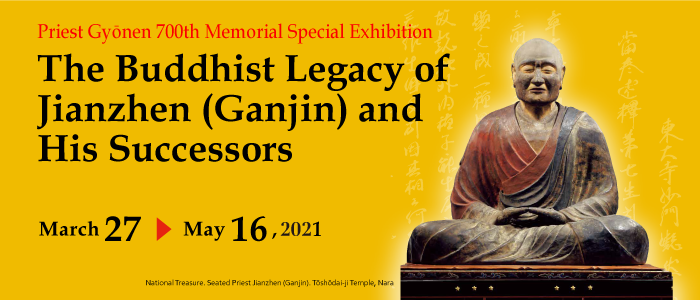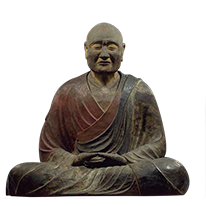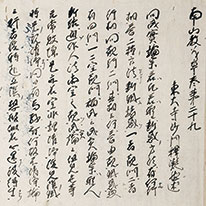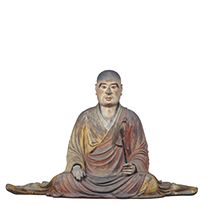General Information
Announcement of Museum Reopening, May 12, 2021–Announcement of Temporary Museum Closure, April 25–May 11, 2021
| Exhibition Title | Priest Gyōnen 700th Memorial Special Exhibition The Buddhist Legacy of Jianzhen (Ganjin) and His Successors |
|---|---|
| Period | March 27 – May 16, 2021 The exhibition has two installations: Part I: March 27 – April 18, 2021 Part II: April 20 – May 16, 2021 Some artworks may be rotated during the exhibition period. Announcement of Museum Reopening, May 12, 2021– Announcement of Temporary Museum Closure, April 25–May 11, 2021 |
| Venue | Kyoto National Museum, Heisei Chishinkan Wing |
| Transportation | JR, Kintetsu Railway, Keihan Railway, Hankyu Railway, City Bus |
| Closed | Mondays Announcement of Museum Reopening, May 12, 2021– Announcement of Temporary Museum Closure, April 25–May 11, 2021 *The museum will be opened on Monday May 3 and closed on Thursday May 6, 2021. |
| Special Exhibition Hours | 9:00 a.m.–5:30 p.m. (Entrance until 5:00 p.m.) *Evening hours on Fridays and Saturdays have been cancelled. |
| Special Exhibition Admission | Adult 1,800 yen (1,600 yen) Univ. Student 1,200 yen (1,000 yen) High School Student 700 yen (500 yen)
For those who have already purchased tickets, they will be usable if the exhibition re-opens. Refunds will be available for any unused tickets (please be aware of the deadline for refunds). For details, see the Special Exhibition Official Website (in Japnese). Please note that ticket refunds cannot be made at the South Gate ticket booth. |
| Audio Guide |
Fee 600 yen (includes tax) Time approx. 35 min Language Japanese, English 9:00 a.m.–4:45 p.m. |
| Catalogue | 3,300 yen. 336 pages. 160 objects. Color plates. Available at the Museum Shop Catalogues of Past Special Exhibitions |
| Organized by | Kyoto National Museum; Tōshōdai-ji Temple, Headquarters of the Risshū Sect; Nikkei Inc.; The Kyoto Shimbun Co., Ltd.; NHK (Japan Broadcasting Station) Kyoto |
| With the special cooperation of | Mitera Sennyū-ji Temple, Headquarters of the Sennyū-ji Branch of the Shingon Sect; Saidai-ji Temple, Headquarters of the Shingon Risshū Sect; Tōdai-ji Temple, Headquarters of the Kegon Sect (alphabetical order) |
| With the support of | Iwatani Corporation; Casio Computer Co., Ltd.; Nissha Co., Ltd.; Nippon Express Co., Ltd.; Mitsui Fudosan Co., Ltd. |
| Special Exhibition Official Website | Priest Gyōnen 700th Memorial Special Exhibition: The Buddhist Legacy of Jianzhen (Ganjin) and His Successors |
Images from the Exhibit
The eminent Tang-dynasty Chinese Buddhist priest Jianzhen (688–763), better known by his Japanese name of Ganjin, was a highly respected master of the Vinaya (Ch: Jielü) school, which is grounded in legal codes of conduct (precepts) and ordination procedures for the Buddhist clergy. Despite his prominent position in his homeland, Ganjin agreed to leave it for Japan in order to establish the Ritsu (or Risshū) school on the invitation of Yōei and Fushō, two Japanese monks dispatched by Emperor Shōmu. After making five failed attempts to cross the sea, and going blind in the meantime, Ganjin finally reached Japanese shores on his sixth trip in the year 753. Thereafter, based out of Nara’s Tōshōdai-ji Temple, he oversaw the reception in Japan of the orthodox Chinese interpretation of the Buddhist precepts, which dramatically improved the quality and legitimacy of Japanese Buddhism.
The concept of vinaya (J: kairitsu), or precepts, comprises both the rules of discipline (J: ritsu) of the monastic community and the moral and ethical standards (J: kai) that members of the clergy and laypeople should follow in their day-to-day lives. Studying the vinaya involves reassessing the meaning of Buddhism and of what it is to be a Buddhist cleric. For this reason, dedicated monks living in times of major social change have often looked back to these fundamental precepts before launching movements to reform and revitalize Japanese Buddhism. This was particularly the case during the Kamakura period, which saw the emergence of a series of brilliant priests from temples in or around the ancient capitals of Nara and Kyoto. They include Kakujō (1194–1249) of Tōshōdai-ji, Eison (1201–1290) of Saidai-ji, Shunjō (1166–1227) of Sennyū-ji, and of course Gyōnen (1240–1321) of Tōdai-ji, whose 700-year memorial is being celebrated with this exhibition. These scholar-monks gained widespread followings by engaging in social welfare projects that reflected vinaya disciplinary codes and mores. Vinaya regulations continued to remain relevant even into the relatively stable society of the early modern period through revival movements led by such notable priests as Myōnin (1576–1610) and Jiun (1718–1805).
This exhibition honors the memory of Ganjin, venerated as one of the true founders of Japanese Buddhism, with a selection of treasures preserved through the centuries at Tōshōdai-ji. These objects, together with masterworks from other temples associated with the vinaya and its revival over the ages, trace the Buddhist legacy of Ganjin and the various luminaries who emerged as his spiritual successors in Japan.
Section 1
Origins of the Precepts: The Formation of a Chinese Vinaya
The vinaya (Ch: lü, J: ritsu) is the division of the Buddhist canon (Skt: tripiṭaka) comprised of precepts and monastic codes attributed to the historical Buddha Shakyamuni, who transmitted these teachings to his disciples in India in response to problems arising from communal monastic living. The consolidation and implementation of these regulations, however, varied across different traditions. As Buddhism entered China, the vinaya played a key role in defining what it meant to be a member of the Buddhist clergy. Because many aspects of Indian social life could not be comprehended through texts alone, Chinese Buddhists traveled to India to study the precepts and the vinaya. This surge of Chinese research culminated in the work of Daoxuan (596–667), whose South Mountain Vinaya School (Ch: Nanshan Lüzong; J: Nanzan Risshū) would flourish as the orthodox vinaya tradition in China for generations.
Section 2
Jianzhen (Ganjin) Arrives in Japan: Jianzhen's Life and the Founding of Tōshōdai-ji Temple
The eminent Tang-dynasty (618–907) Buddhist master Jianzhen (688–763), better known in Japan as Ganjin, was born in Yangzhou (Jiangsu province) and followed in the vinaya tradition of Daoxuan (596–667). In 742, while serving as the chief administrator of Daming-si Temple in Yangzhou, he was visited by two Japanese clerics in service to Emperor Shōmu (701–756), Yōei and Fushō, who entreated him to return with them to transmit the precepts to Japan. Relinquishing his position, Jianzhen made five failed attempts to cross the sea, finally reaching Japanese shores afier the sixth attempt in the year 753. Despite losing his eyesight during the diffcult journey, Jianzhen was welcomed with great fanfare by those both in and outside of the Nara court. Afier establishing a precepts ordination platform at Tōdai-ji Temple, he was granted his own temple, Tōshōdai-ji, where he would train a new generation of disciples. This section of the exhibition centers on the National Treasure portrait sculpture of Jianzhen (Ganjin), and it traces the legacy of the eminent cleric.
Section 3
A Turning Point in Japanese Vinaya Thought: Saichō and Kūkai
As Japanese Buddhism turned increasingly toward the salvation of broader society, approaches to the
precepts also
evolved. The first major change occurred with Saichō (767–822), founder of the Japanese Tendai
school. Saichō believed that Japan’s physical and temporal distance from Shakyamuni hindered the
observance of the precepts in their received form, and he instead advocated the Bodhisattva
Precepts as a basic model that all Buddhists could follow. This position ran counter to the
teachings of the Nara schools and marked a major turning point that would be carried on by the Pure
Land school (Jōdo Shū) patriarch Hōnen (1133–1212), the True Pure Land, or Shin, school (Jōdo
Shinshū) patriarch Shinran (1173–1263), and the Nichiren Lotus school (Nichiren Hokkeshū) patriarch
Nichiren (1222–1282).
In addition, Shingon school founder Kūkai's (774–835) transmission of Esoteric Buddhism from
Tang-dynasty China also introduced the new esoteric Samaya Precepts (J: Sanmayakai). Esoteric
Buddhism’s emphasis on origins and authenticity paved the way for later precepts revival movements
that would seek to return to the ultimate point of
origin—the Buddha Shakyamuni.
Section 4
The Height of Precepts Movements in Japan: "Kamakura New Buddhism" and Social Movements
The precepts played an important role in the socially oriented Buddhist reform movements that characterize what is referred to as "Kamakura New Buddhism." With their efforts to revive the precepts based at their respective temples Tōshōdai-ji and Saidai-ji in Nara, the priests Kakujō (1194–1249) and Eison (1201–1290) laid the foundations for the current Vinaya school (J: Risshū) and Esoteric Vinaya school (J: Shingon Risshū). The Kaidan-in Ordination Hall at Tōdai-ji Temple also continued to serve as a center for the study of the precepts, as represented by the appearance of the scholar-monk Gyōnen (1240–1321). These clerics trained numerous disciples and carried out social welfare projects through solicitation activities that cultivated popular support, exerting enormous influence throughout the Kamakura period (1185–1333). In addition, the priest Shunjō (1166–1227) traveled to China during the Southern Song dynasty (1127–1279) to study the precepts; on his return, he promoted these teachings at the Kyoto temple of Sennyū-ji. The objects introduced here reflect the fervent aspirations of individuals engaged in Buddhist reforms.
Section 5
Vinaya Revival in the Early Modern Period
The early modern period once again witnessed a flourishing of precepts revival activities. These movements were initiated by the priest Myōnin (1576–1610) of Saimyō-ji Temple in Kyoto. During this "second precepts renaissance" a number of brilliant individuals emerged across the different sects, perhaps most notably Jiun (1718–1805), who was famous as a leading scholar of Sanskrit studies. It is this intellectual attitude to seek out the source of Buddhism that characterizes early modern vinaya revival movements. Throughout the metropolitan areas of Osaka and Edo (present-day Tokyo), these reformers brought a rational approach to their engagement with society, greatly contributing to the formation of occupational ethics among members of the emerging urban class who engaged in commerce and industry. Early modern precepts thought was an especially salient presence in Edo-period (1615–1868) Buddhism and had an inventiveness to it that carried through the modern Buddhist reform movements of the Meiji period (1868–1912) and thereafier.














![Buddhist Patriarchs of Three Countries. Ōtani University Museum, Kyoto [on view: April 20–May 16, 2021]](../../../jp/special/img/20210327/kairitsu_1-3_sangoku-do_tmb.jpg)
![Buddhist Patriarchs of Three Countries. Ōtani University Museum, Kyoto [on view: April 20–May 16, 2021]](../../../jp/special/img/20210327/kairitsu_1-2_sangoku_tmb.jpg)
![Important Cultural Property. Record of the Transmission of the Precepts (J: Kairitsu denraiki), Vol. 1. Tōshōdai-ji Temple, Nara [on view: March 27–April 18, 2021]](../../../jp/special/img/20210327/kairitsu_1-1_kairitsu_tmb.jpg)
![Important Cultural Property. Eastern Journey of the Priest Jianzhen, Vol. 2. By Rengyō. Tōshōdai-ji Temple, Nara [this section on view: March 27–April 18, 2021]](../../../jp/special/img/20210327/kairitsu_2-1_toseiden2_tmb.jpg)
![Important Cultural Property. Eastern Journey of the Priest Jianzhen, Vol. 4. By Rengyō. Tōshōdai-ji Temple, Nara [this section on view: April 20–May 16, 2021]](../../../jp/special/img/20210327/kairitsu_2-2_toseiden4_tmb.jpg)
![National Treasure. Enchin's Ordination. Tokyo National Museum [on view: March 27–April 18, 2021]](../../../jp/special/img/20210327/kairitsu_3-1_enchin_tmb.jpg)
![National Treasure. Illustrated Biography of the Venerable Hōnen, Vol. 10. Chion-in Temple, Kyoto [Vol. 10 on view: April 20–May 16, 2021]](../../../jp/special/img/20210327/kairitsu_3-2_legend10_tmb.jpg)

![National Treasure. Seated Portrait of Eison (Kōshō Bosatsu). By Zenshun. Saidai-ji Temple, Nara [on view: April 20–May 16, 2021] Photo by Morimura Kinji](../../../jp/special/img/20210327/kairitsu_4-3_eison_tmb.png)
![Jiun in Seated Meditation on a Rock. By Hara Zaichū. Inscription by Jiun. Kōki-ji Temple, Osaka [on view: March 27–April 18, 2021]](../../../jp/special/img/20210327/kairitsu_5-1_koin_tmb.jpg)
